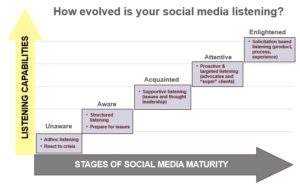Are You an Expert Social Media Listener?
Do you think your social media strategy is evolved? If you are not an expert social media listener – then your social media strategy is not as mature as it could be.
There are a number of social media maturity models and capability assessments available by several leading marketing thought leadership organizations. Interestingly, the majority of these models and assessments suggest that “listening” is an early stage of social media progression or maturity.
I couldn’t disagree more.
Social listening is a critical capability at every stage of an organization’s social strategy development and for some businesses it should evolve to an expert level of social listening. Given the global nature of social media – becoming a social listening expert is important in order to meet the demands driven by regional, cultural and language considerations.
There are varying levels of the Social Media Listening capabilities that are building blocks. Each step includes a new type of Social Listening that is added to existing listening capabilities already embraced as part of an organization’s social media strategy or tactics.
Based on my research and experience there five different types of Social Listening.

- Ad-hoc Listening
From a social media perspective, organizations that primarily rely upon ad-hoc listening are unaware of what is being said, where it is being said and by whom. As well, they are likely unaware of the full potential impact, both positive and negative that social media will have on their bottom line. They may doubt the validity of social media insight. They may be periodically listening and are not prepared to response and if they do respond, it is in an ad-hoc manner. Given the complexity of social media, it might simply be that they don’t know where to start. So in response, they listen after a major issue has gained popularity or is “not going away” and they are forced to try and resolve it now that it has become “public”.
- Structured Listening
This type of listening is typically used by organizations that want to become aware of what is being said, where it is being said and by whom. They likely already have a high-level understanding of the potential impact both positive and negative that social media will have on their bottom line. They go about monitoring through manual or automated means and do so on a semi-regular basis. This enables them to be better prepared as issues arise in the social media world to minimize their impact or resolve them altogether. They may be leveraging advocacy type postings to further amplify positive word of mouth. But they are doing so in an opportunistic fashion.
- Supportive Listening
Organizations that have Supportive Listening capabilities are well acquainted with social media, are very aware of what is being said, where it is being said and by whom. As well, they likely have a good understanding of the actual impact, both positive and negative, that social media has on their bottom line. These organizations are targeting their social media advocates and “super clients” with thought leadership insights to drive word of mouth.
This type of listening moves beyond regular manual and automated monitoring to deeper social media research focused on customer business issues and thought leadership insights. It is this type of listening that will provide support for a broader approach to an organization’s social media strategy such as growing it beyond a marketing communications tactic.
- Proactive Listening
Those organizations that have gone through the discipline of obtaining alignment to social media goals, objectives and strategies are very likely proactively listening to the social media world. They would be likely described as being intimately aware of their social media voice (specifically share and tone). Furthermore, they are targeting their social media advocates and “super clients” to gather customer experience, process and product development insights that are volunteered.
- Solicitation
Solicitation based listening is demonstrated by organizations that have an enlightened social media strategy. They are proactively soliciting their social media advocates and “super clients” on a variety of topics, issues and solutions. They engage in social and digital mining which involves mining articles and conversations to understand their context, sentiment, and relevance. They examine posts, comments, and shares of those articles and conversations for differing points of view or alignment. These organizations are actively soliciting and driving these insights into their customer experience management, process improvements, and product development initiatives.
What types of Social Listening should you be using?
As you can see, social media listening can take many forms. As a first step, make an honest assessment of what types of social listening you are using. Then determine what types of insight would support your customer experience, product development or process improvement initiatives and if that is important to your team, department or organization. You will then be in a better position to determine what types of social listening you need to adopt so that you can become a social listening expert.
follow me @greefkes on most social sites.
Adapted from a whitepaper published at filigreeconsulting.com










